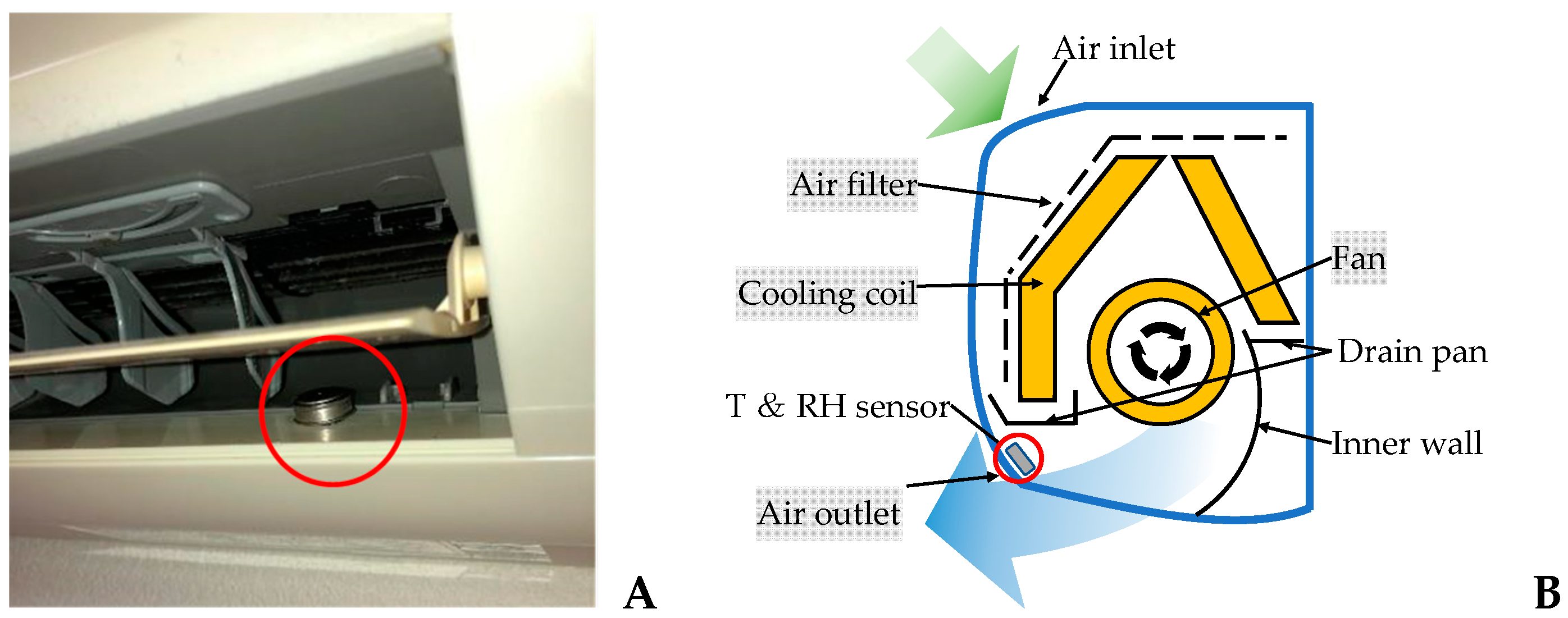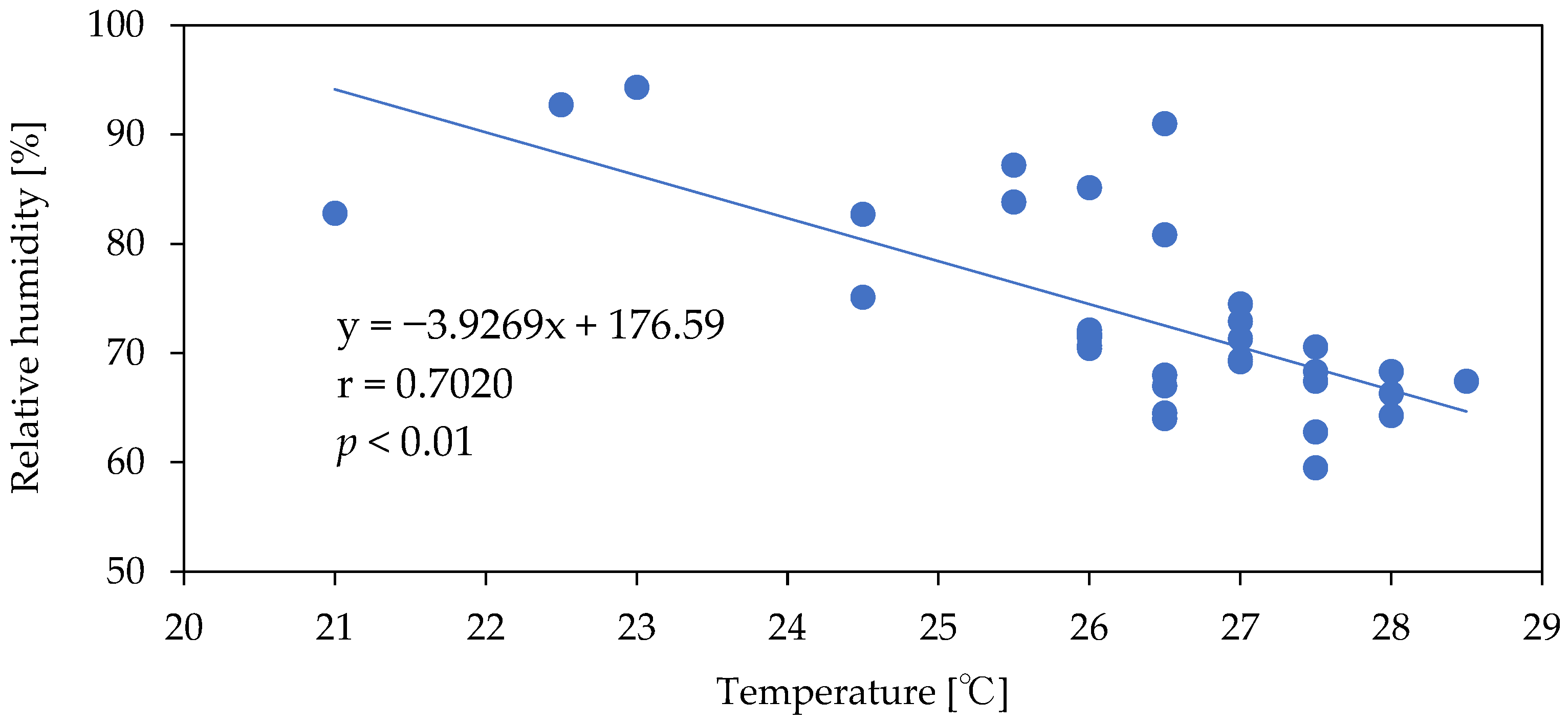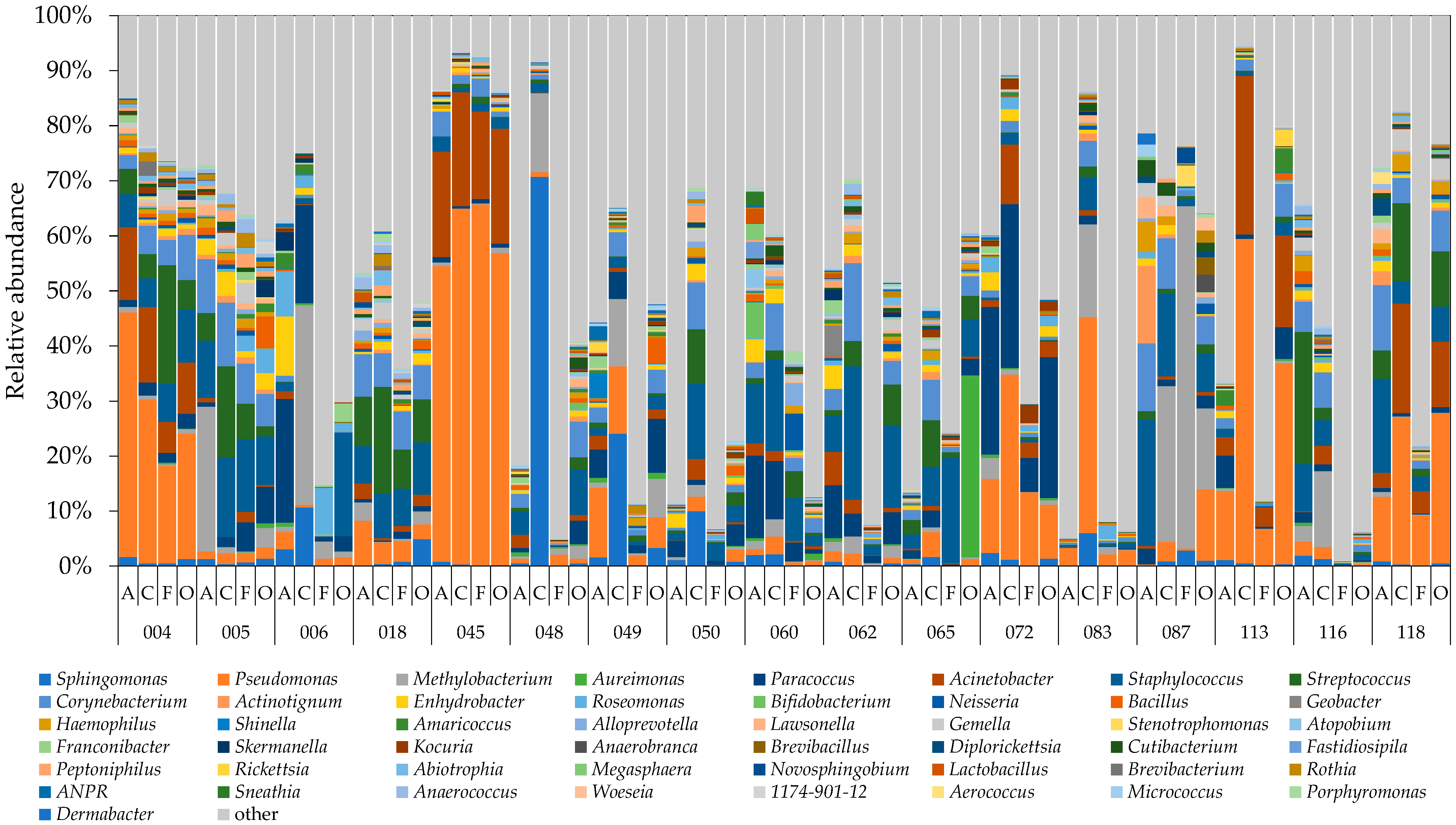Bacterial Communities in Various Parts of Air-Conditioning Units in 17 Japanese Houses
Abstract
:1. Introduction
2. Materials and Methods
2.1. Measured Locations
2.2. Temperature and Relative Humidity
2.3. DNA Extraction, Amplification, and Sequencing
2.3.1. DNA Extraction
2.3.2. DNA Amplification and Sequencing
2.3.3. DNA Sequencing and Analysis
3. Results
3.1. Temperature and Humidity
3.2. Taxonomic Analysis
3.2.1. Taxonomic Identification
3.2.2. Phylum
3.2.3. Genus
3.2.4. Change in Ranking of Bacteria Adhering to Various Parts of Air Conditioners
3.2.5. Diversity of Bacterial Community
4. Discussion
5. Conclusions
Supplementary Materials
Author Contributions
Funding
Data Availability Statement
Conflicts of Interest
References
- Klepeis, N.E.; Nelson, W.C.; Ott, W.R.; Robinson, T.A.M.; Switzer, P.; Behar, J.V.; Hern, S.C.; Engelmann, W.H. The National Human Activity Pattern Survey (NHAPS): A resource for assessing exposure to environmental pollutants. J. Expo. Anal. Env. Epid. 2001, 11, 231–252. [Google Scholar] [CrossRef] [Green Version]
- Adams, R.I.; Bhangar, S.; Dannemiller, K.C.; Eisen, J.A.; Fierer, N.; Gilbert, J.A.; Green, J.L.; Miller, S.L.; Siegel, J.A.; Stephens, B.; et al. Ten questions concerning the microbiomes of buildings. Build. Environ. 2016, 109, 224–234. [Google Scholar] [CrossRef] [Green Version]
- Gilbert, J.A.; Stephens, B. Microbiology of the built environment. Nat. Rev. Microbiol. 2018, 16, 661–670. [Google Scholar] [CrossRef] [PubMed]
- Prussin, A.J.; Marr, L.C. Sources of airborne microorganisms in the built environment. Microbiome 2015, 3, 78. [Google Scholar] [CrossRef] [PubMed] [Green Version]
- Adams, R.I.; Bateman, A.C.; Bik, H.M.; Meadow, J.F. Microbiota of the indoor environment: A meta-analysis. Microbiome 2015, 3, 1–18. [Google Scholar] [CrossRef] [PubMed] [Green Version]
- Hoisington, A.; Maestre, J.P.; Kinney, K.A.; Siegel, J.A. Characterizing the bacterial communities in retail stores in the United States. Indoor Air 2016, 26, 857–868. [Google Scholar] [CrossRef] [PubMed]
- Hospodsky, D.; Qian, J.; Nazaroff, W.W.; Yamamoto, N.; Bibby, K.; Rismani-Yazdi, H.; Peccia, J. Human occupancy as a source of indoor airborne bacteria. PLoS ONE 2012, 7, e34867. [Google Scholar] [CrossRef] [Green Version]
- Qian, J.; Hospodsky, D.; Yamamoto, N.; Nazaroff, W.W.; Peccia, J. Size-resolved emission rates of airborne bacteria and fungi in an occupied classroom. Indoor Air. 2012, 22, 339–351. [Google Scholar] [CrossRef] [PubMed] [Green Version]
- Täubel, M.; Rintala, H.; Pitkäranta, M.; Paulin, L.; Laitinen, S.; Pekkanen, J.; Hyvärinen, A.; Nevalainen, A. The occupant as a source of house dust bacteria. J. Allergy Clin. Immunol. 2009, 124, 834–840. [Google Scholar] [CrossRef]
- Leung, M.H.Y.; Lee, P.K.H. The roles of the outdoors and occupants in contributing to a potential pan-microbiome of the built environment: A review. Microbiome 2016, 4, 21. [Google Scholar] [CrossRef]
- Yanagi, U.; Kato, S.; Nagano, H.; Ito, K.; Yamanaka, T.; Momoi, Y.; Kobayashi, H.; Hayama, H. Dispersion characteristics of oral microbial communities in a built environment. Jpn. Archit. Rev. 2022, 5, 225–232. [Google Scholar] [CrossRef]
- Barberán, A.; Dunn, R.R.; Reich, B.J.; Pacifici, K.; Laber, E.B.; Menninger, H.L.; Morton, J.M.; Henley, J.B.; Leff, J.W.; Miller, S.L.; et al. The ecology of microscopic life in household dust. Proc. R. Soc. B 2015, 282, 20151139. [Google Scholar] [CrossRef] [PubMed]
- Ownby, D.R.; Johnson, C.C.; Peterson, E.L. Exposure to dogs and cats in the first year of life and risk of allergic sensitization at 6 to 7 years of age. J. Am. Med. Assoc. 2002, 288, 963–972. [Google Scholar] [CrossRef] [PubMed] [Green Version]
- Berg, G.; Mahnert, A.; Moissl-Eichinger, C. Beneficial effects of plant-associated microbes on indoor microbiomes and human health? Front. Microbiol. 2014, 5, 15. [Google Scholar] [CrossRef] [PubMed] [Green Version]
- Burge, H.A.; Solomon, W.R.; Muilenberg, M.L. Evaluation of indoor plantings as allergen exposure sources. J. Allergy Clin. Immunol. 1982, 70, 101–108. [Google Scholar] [CrossRef]
- Li, A.; Xiong, J.; Yao, L.; Gou, L.; Zhang, W. Determination of dust and microorganism accumulation in different designs of AHU system in Shaanxi History Museum. Build. Environ. 2016, 104, 232–242. [Google Scholar] [CrossRef] [Green Version]
- Ager, B.P.; Tickner, J.A. The control of microbiological hazards associated with air-conditioning and ventilation systems. Ann. Occup. Hyg. 1983, 27, 341–358. [Google Scholar] [CrossRef]
- Batterman, S.A.; Burge, H. HVAC systems as emission sources affecting indoor air quality: A critical review. HVAC R Res. 1995, 1, 61–78. [Google Scholar] [CrossRef]
- Hugenholtz, P.; Fuerst, J.A. Heterotrophic bacteria in an air handling system. Appl. Environ. Microbiol. 1992, 58, 3914–3920. [Google Scholar] [CrossRef] [Green Version]
- Hatayama, K.; Oikawa, Y.; Ito, H. Bacterial community structures in air conditioners installed in Japanese residential buildings. Antonie Leeuwenhoek 2018, 11, 45–53. [Google Scholar] [CrossRef]
- Bakker, A.; Siegel, J.A.; Mendell, M.J.; Peccia, J. Building and environmental factors that influence bacterial and fungal loading on air conditioning cooling coils. Indoor Air 2018, 28, 689–696. [Google Scholar] [CrossRef] [PubMed]
- Bakker, A.; Siegel, J.A.; Mendell, M.J.; Prussin, A.J.; Marr, L.C.; Peccia, J. Bacterial and fungal ecology on air conditioning cooling coils is influenced by climate and building factors. Indoor Air 2019, 30, 326–334. [Google Scholar] [CrossRef] [PubMed]
- Simmons, R.B.; Rose, L.J.; Crow, S.A.; Ahearn, D.G. The Occurrence and Persistence of Mixed Biofilms in Automobile Air Conditioning Systems. Curr. Microbiol. 1999, 39, 141–145. [Google Scholar] [CrossRef] [PubMed]
- Diekmann, N.; Burghartz, M.; Remus, L.; Kaufholz, A.L.; Nawrath, T.; Rohde, M.; Schulz, S.; Roselius, L.; Schaper, J.; Mamber, O.; et al. Microbial communities related to volatile organic compound emission in automobile air conditioning units. Appl. Microbiol. Biotechnol. 2013, 97, 8777–8793. [Google Scholar] [CrossRef] [PubMed]
- Japanese Agency for Natural Resources and Energy. Available online: https://www.meti.go.jp/shingikai/enecho/shoene_shinene/sho_energy/air_denki/pdf/002_04_00.pdf (accessed on 7 October 2022). (In Japanese).
- Banaszak, E.F.; Thiede, W.H.; Fink, J.N. Hypersensitivity pneumonitis due to contamination of an air conditioner. N. Engl. J. Med. 1970, 283, 271–276. [Google Scholar] [CrossRef]
- Baur, X.; Behr, J.; Dewair, M.; Ehret, W.; Fruhmann, G.; Vogelmeier, C.; Weiss, W.; Zinkernagel, V. Humidifier Lung and Humidifier Fever. Lung 1988, 166, 113–124. [Google Scholar] [CrossRef]
- Acierno, L.J.; Lytle, J.S.; Sweeney, M.J. Acute Hypersensitivity Pneumonitis Related to Forced Air Systems—A Review of Selected Literature And a Commentary on Recognition and Prevention. J. Environ. Health 1985, 48, 138–141. [Google Scholar]
- Braun-Fahrlander, C.; Riedler, J.; Herz, U.; Eder, W.T.; Waser, M.; Grize, L.; Maish, A.; Carr, D.; Gerlach, F.; Bufe, A.; et al. Environmental exposure to endotoxin and its relation to asthma in school-age children. N. Eng. J. Med. 2002, 347, 869–877. [Google Scholar] [CrossRef] [Green Version]
- Williams, L.K.; Ownby, D.R.; Maliarik, M.J.; Johnson, C.C. The role of endotoxin and its receptors in allergic disease. Ann. Allergery Asthma Immunol. 2005, 94, 323–332. [Google Scholar] [CrossRef] [Green Version]
- Flaherty, D.K.; Deck, F.H.; Cooper, J.; Bishop, K.; Winzenburger, P.A.; Smith, L.R.; Bynum, L.; Witmer, W.B. Bacterial endotoxin isolated from a water spray air humidification system as a putative agent of occupation-rated lung disease. Infect. Immunol. 1984, 43, 206–212. [Google Scholar] [CrossRef] [Green Version]
- Heederik, D.; Brouwer, R.; Biersteker, K.; Boleij, J.S. Relationship of airborne endotoxin and bacterial levels in pig farms with the lung fuction and respiratory symptoms of farmers. Int. Arch. Occup. Environ. Health 1991, 62, 595–601. [Google Scholar] [CrossRef] [PubMed]
- Milton, D.K.; Wypij, D.; Walters, M.; Hammond, S.K.; Evans, J. Endotoxin exposure-response in a fiberglass manufacturing plant. Am. J. Indust. Med. 1996, 29, 3–13. [Google Scholar] [CrossRef]
- Dannemiller, K.C.; Weschler, C.J.; Peccia, J. Fungal and bacterial growth in floor dust at elevated relative humidity levels. Indoor Air 2017, 27, 354–363. [Google Scholar] [CrossRef]
- Hyvärinen, A.; Meklin, T.; Vepsäläinen, A.; Nevalainen, A. Fungi and actinobacteria in moisture-damaged building materials— concentrations and diversity. Int. Biodeterior. Biodegradation. 2002, 49, 27–37. [Google Scholar] [CrossRef]
- Schmidt, M.G.; Attaway, H.H.; Terzieva, S.; Marshall, A.; Steed, L.L.; Salzberg, D.; Hamoodi, H.A.; Khan, J.A.; Feigley, C.E.; Michels, H.T. Characterization and Control of the Microbial Community Affiliated with Copper or Aluminum Heat Exchangers of HVAC Systems. Curr. Microbiol. 2012, 65, 141–149. [Google Scholar] [CrossRef] [PubMed] [Green Version]
- Caporaso, J.G.; Lauber, C.L.; Walters, W.A.; Berg-Lyons, D.; Lozupone, G.A.; Turnbaugh, P.J.; Fierer, N.; Knight, R. Global patterns of 16S rRNA diversity at a depth of millions of sequences per sample. Proc. Natl. Acad. Sci. USA 2011, 108 (Suppl. S1), 4516–4522. [Google Scholar] [CrossRef] [Green Version]
- Ryan, M.P.; Adley, C.C. Sphingomonas paucimobilis: A persistent Gram negative nosocomial infectious organism. J. Hosp. Infect. 2010, 75, 153–157. [Google Scholar] [CrossRef]
- Lozupone, C.A.; Hamady, M.; Kelley, S.T.; Knight, R. Quantitative and Qualitative β Diversity Measures Lead to Different Insights into Factors That Structure Microbial Communities. Appl. Environ. Microbiol. 2007, 73, 1576–1585. [Google Scholar] [CrossRef] [Green Version]
- Pickering, A.C.; Fitzgerald, J.R. The Role of Gram-Positive Surface Proteins in Bacterial Niche- and Host-Specialization. Front. Microbiol. 2020, 11, 1–9. [Google Scholar] [CrossRef]
- Yano, T.; Miyahata, Y.; Yokohata, R.; Hanai, J.; Matsuo, S.; Hiratsuka, E.; Okano, T.; Kubota, H. Analyses and Regulation of Biofilms in Actual Environments. J. Environ. Biotecthnol. 2015, 14, 125–129. Available online: https://www.jseb.jp/wordpress/wp-content/uploads/14-02-125.pdf (accessed on 1 October 2022). (In Japanese).





| ID | Building Age | Type of Residental Building | AC Set Point | Frequency of Use | Hours of Opretion | Years of Use | Number of Residents | |
|---|---|---|---|---|---|---|---|---|
| (Years) | (Floors) | (°C) | (Day/Week) | (h/day) | (Years) | |||
| 004 | 13 | Detached house | 1 | 29 | 7 | 12 | 13 | 2 |
| 005 | 16 | Detached house | 1 | 28 | 7 | 24 | 16 | 2 |
| 006 | 19 | Detached house | 1 | 26 | 7 | 17 | 6 | 5 |
| 018 | 42 | Comdminium | 2 | 26 | 4.5 | 12 | 10 | 2 |
| 045 | 51 | Detached house | 1 | 28 | 1 | 2 | 5 | 2 |
| 048 | 31 | Comdminium | 1 | 27 | 7 | 8 | 6 | 2 |
| 049 | 44 | Detached house | 1 | 26 | 7 | 9 | 10 | 2 |
| 050 | 45 | Detached house | 1 | 26 | 7 | 15 | 8 | 2 |
| 060 | 11 | Detached house | 1 | 23~25 | 7 | 12 | 1.6 | 2 |
| 062 | 24 | Detached house | 1 | 27 | 7 | 14 | 13 | 2 |
| 065 | 49 | Detached house | 1 | 26 | 7 | 10 | 4 | 2 |
| 072 | 16 | Detached house | 1 | 27 | 7 | 16 | 2 | 3 |
| 083 | 28 | Detached house | 2 | 28 | 7 | 4 | 8 | 4 |
| 087 | 23 | Comdminium | 13 | 28 | 7 | 24 | 12 | 2 |
| 113 | 41 | Detached house | 1 | 28 | 7 | 5 | 13 | 2 |
| 116 | 27 | Comdminium | 3 | 26 | 7 | 24 | 10 | 2 |
| 118 | 7 | Detached house | 1 | 26 | 5 | 10 | 7 | 2 |
| Air Filter | Cooling Coil | Fan | Air Outlet | ||||
|---|---|---|---|---|---|---|---|
| Pseudomonas | 1 | → | 1 | → | 1 | → | 1 |
| Staphylococcus | 2 | ⤵ | 4 | ⤴ | 3 | ⤴ | 2 |
| Paracoccus | 3 | ⤵ | 8 | ⤴ | 7 | ⤴ | 3 |
| Corynebacterium | 4 | ⤵ | 6 | → | 6 | ⤴ | 5 |
| Acinetobacter | 5 | → | 5 | → | 5 | ⤴ | 4 |
| Streptococcus | 6 | ⤵ | 7 | ⤴ | 4 | ⤵ | 7 |
| Methylobacterium | 7 | ⤴ | 2 | → | 2 | ⤵ | 9 |
| Enhydrobacter | 8 | ⤵ | 9 | ⤵ | 16 | ⤴ | 12 |
| Sphingomonas | 9 | ⤴ | 3 | ⤵ | 17 | ⤵ | 11 |
| Actinotignum | 10 | ⤵ | 29 | ⤴ | 25 | ⤴ | 24 |
Publisher’s Note: MDPI stays neutral with regard to jurisdictional claims in published maps and institutional affiliations. |
© 2022 by the authors. Licensee MDPI, Basel, Switzerland. This article is an open access article distributed under the terms and conditions of the Creative Commons Attribution (CC BY) license (https://creativecommons.org/licenses/by/4.0/).
Share and Cite
Watanabe, K.; Yanagi, U.; Shiraishi, Y.; Harada, K.; Ogino, F.; Asano, K. Bacterial Communities in Various Parts of Air-Conditioning Units in 17 Japanese Houses. Microorganisms 2022, 10, 2246. https://doi.org/10.3390/microorganisms10112246
Watanabe K, Yanagi U, Shiraishi Y, Harada K, Ogino F, Asano K. Bacterial Communities in Various Parts of Air-Conditioning Units in 17 Japanese Houses. Microorganisms. 2022; 10(11):2246. https://doi.org/10.3390/microorganisms10112246
Chicago/Turabian StyleWatanabe, Kensuke, U Yanagi, Yoshiki Shiraishi, Kazuhiro Harada, Fumitoshi Ogino, and Koichiro Asano. 2022. "Bacterial Communities in Various Parts of Air-Conditioning Units in 17 Japanese Houses" Microorganisms 10, no. 11: 2246. https://doi.org/10.3390/microorganisms10112246
APA StyleWatanabe, K., Yanagi, U., Shiraishi, Y., Harada, K., Ogino, F., & Asano, K. (2022). Bacterial Communities in Various Parts of Air-Conditioning Units in 17 Japanese Houses. Microorganisms, 10(11), 2246. https://doi.org/10.3390/microorganisms10112246






